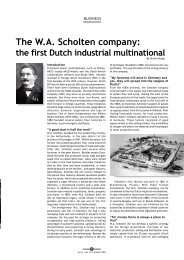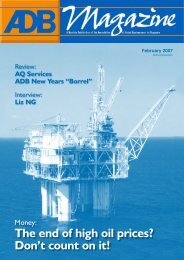(street) name? - Association of Dutch Businessmen
(street) name? - Association of Dutch Businessmen
(street) name? - Association of Dutch Businessmen
You also want an ePaper? Increase the reach of your titles
YUMPU automatically turns print PDFs into web optimized ePapers that Google loves.
Jeroen is CEO <strong>of</strong> Blue<br />
Anchor Consulting, a<br />
Financial Consulting,<br />
Advice and Intermediation<br />
firm and can be reached at<br />
jeroen.thijs@gmail.com<br />
MONEY<br />
A modern day gold rush?<br />
In the May issue <strong>of</strong> your ADB magazine, I wrote about the investment opportunity in commodities in<br />
general. Since then prices have continued their relentless rise. For instance, I mentioned that silver<br />
had doubled since the commodities bull market began in 2001. Well, just slightly over a month later<br />
silver has actually now more than tripled since 2001, having risen 40% just over the past 2 months. The<br />
same story goes for gold, which has risen almost USD200 since the beginning <strong>of</strong> this year. Although we<br />
are now (mid May) in some sort <strong>of</strong> intermediate correction, which could take some time to play out, no<br />
one can predict what the price <strong>of</strong> silver or gold will be at the time <strong>of</strong> distribution <strong>of</strong> the June issue and<br />
I certainly don’t want to give it a go.<br />
I would not want to write every week about commodities, but I think it is a good idea at this stage,<br />
given current market developments, to look at one specific ‘commodity’, i.e. gold, study fundamental<br />
reasons behind the current rise and whether or not it is still a good time to invest in gold.<br />
The reason that I put the word commodity in inverted commas is that gold stands out from all other<br />
commodities, as its supply and demand characteristics are not driven by industrial use <strong>of</strong> the metal.<br />
Apart from jewellery, gold’s demand is, and has been for over 2500 years, driven by the fact that it is<br />
considered as a medium <strong>of</strong> exchange and the ultimate store <strong>of</strong> value. The history <strong>of</strong> gold as money spans<br />
from 700BC till about 1930AD. From 1930 till 1970 we had a paper-based system linked to gold and a<br />
mere 35 years ago, we abolished gold as any form <strong>of</strong> money.<br />
It is no surprise then, that the bulk <strong>of</strong> the current generation <strong>of</strong> investors or people working in the<br />
financial services industry in the west have a bad or no perception about the value <strong>of</strong> gold since the gold<br />
standard was abolished by president <strong>of</strong> the United States, Richard Nixon on August 15, 1971. After rising<br />
to about USD850 in 1980, gold entered into a 20-year bear market and bottomed at about USD250 in<br />
2001. The perception was not aided by the fact that most central banks in the world engaged in an<br />
active and aggressive program <strong>of</strong> selling their gold reserves. For instance, Gordon Brown, Chancellor <strong>of</strong><br />
the Exchequer, sold 60% <strong>of</strong> the UK’s gold reserves in 2001, the absolute bottom <strong>of</strong> the cycle! Although I<br />
leave it up to you to decide on his timing, it did not exactly create many gold-bulls in the investing<br />
community.<br />
How times have changed. Gold has since risen about 190% and it is only very recently that a small<br />
part <strong>of</strong> the investment community is starting to take notice. The bullish trend is now well established<br />
and the main explanations put forward are linked to the fundamental demand/supply situation, increasing<br />
inflation concerns, rising geopolitical risks and fears over the US dollar. Let’s look at them one by one.<br />
Demand and supply<br />
The World Gold Council estimates that mine production has been essentially flat since the end <strong>of</strong> the<br />
1990’s and fell by 5% in 2004. Given the 20-year bear market in gold there has been massive underinvestment<br />
in new gold exploration efforts. Gold reserves are coming under pressure as existing gold<br />
mines mature and mining companies find it increasingly difficult to replace current production with new<br />
discoveries. For many countries it is not (yet) economically feasible to extract gold at greater depths<br />
and lower grades, and, once deep shafts close, they seldom reopen. With demand rising at an ever<br />
faster pace and central bank selling abating or even reversing (Russia and China are strong buyers for<br />
instance), the gold market is now in a deficit and this has lead and will continue to lead to a strong<br />
upward push on the price. On top <strong>of</strong> this many gold producers continue to de-hedge their books; an<br />
additional strong demand driver.<br />
12<br />
Vol.16 • No. 5 • June 2006
















